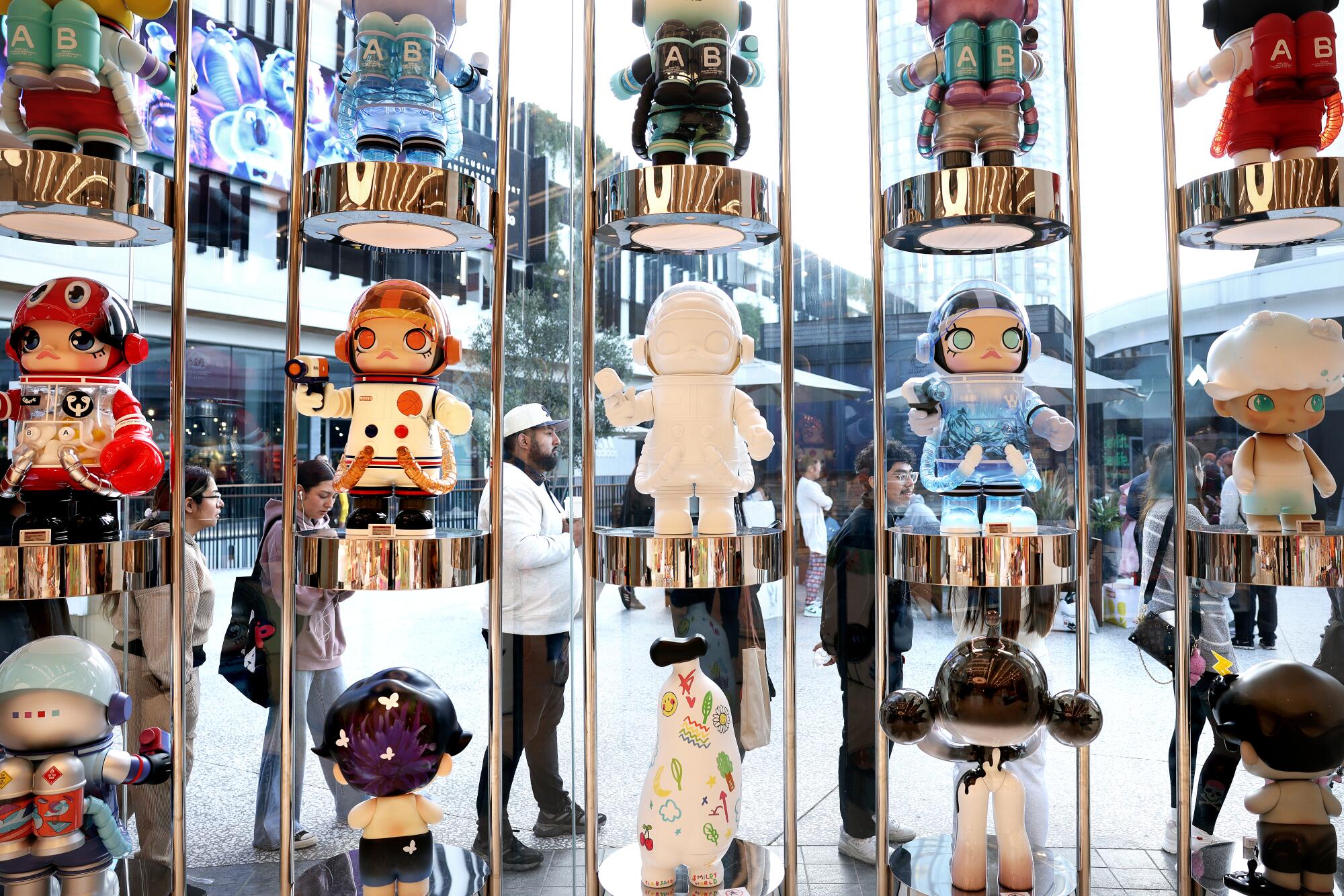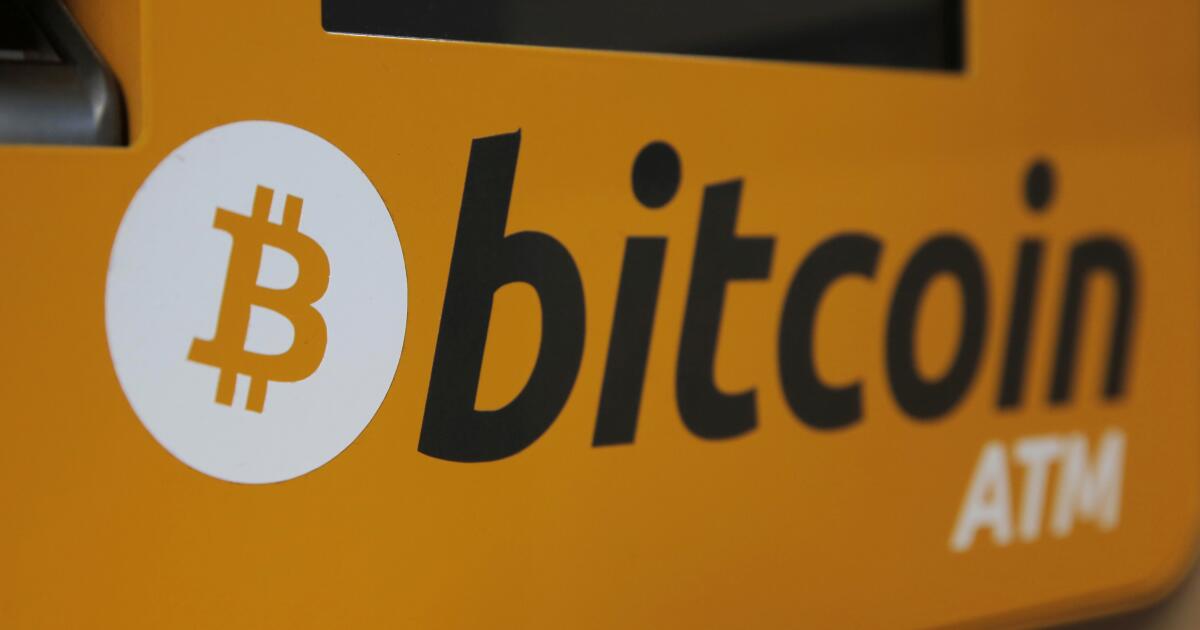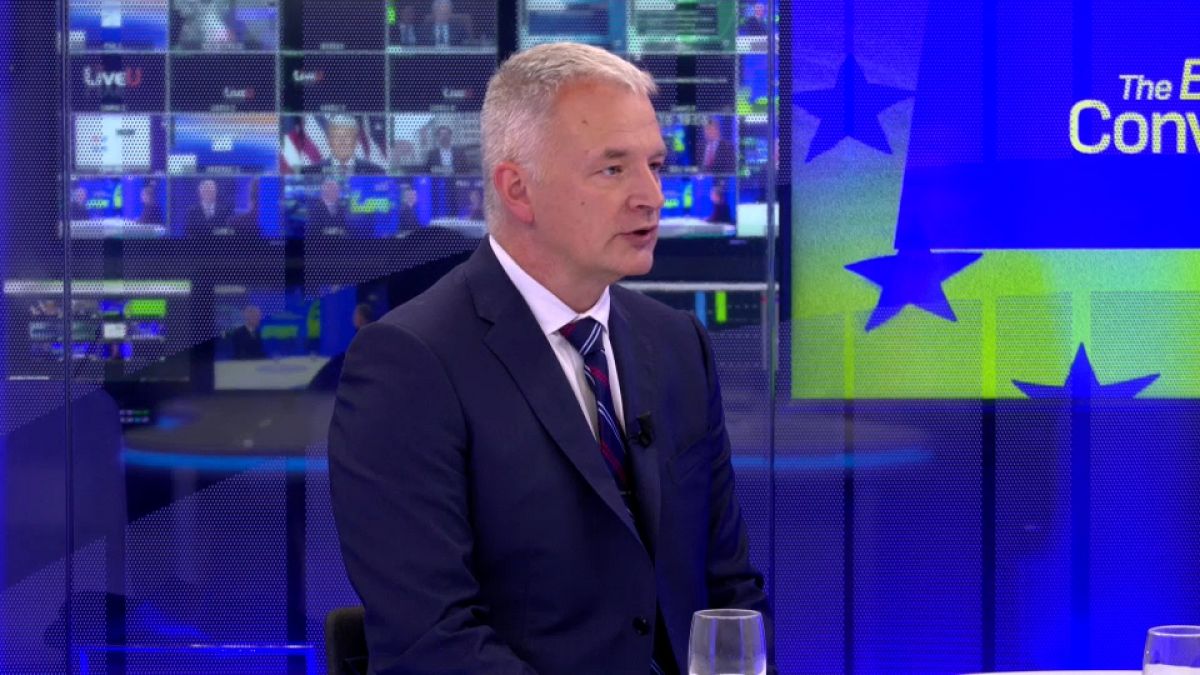Business
Overnight lines, mall fights and instant sellouts: Labubu toy mania comes to America

Every few Fridays, in the middle of the night, a line forms outside the Pop Mart store at Westfield Century City.
It’s the same scene over at Glendale Galleria. And at South Coast Plaza. Victoria Gardens in Rancho Cucamonga, too.
They come by the hundreds, all vying for the latest Labubu, a furry toy character with rabbit-like ears and a nightmarish grin stretched wide over a row of serrated teeth. Labubu, her legion of fans will tell you, is female, the size of a cat and a tad mischievous. She belongs to a Nordic tribe of elves known as the Monsters. She is very soft. They insist her boyfriend is a look-alike figure named Zimomo, but Pop Mart denies the relationship.
A global buying frenzy for all things Labubu erupted in April when Lisa, a member of the popular K-pop girl group Blackpink, posted a video on Instagram of her hugging a large Labubu plush doll. The 27-year-old megastar, who isn’t a brand spokesperson, further fueled the mania by accessorizing her luxury handbags with small Labubu pendants.
Since then, every new release and restock of the plush dolls has sold out within minutes in stores and within seconds online. Grown men and women — Labubu’s core customers are adults, not kids — have fought over her and police recently had to manage an unruly crowd at a Singapore toy show where Labubus were being sold. Last month, a family allegedly broke into a claw machine filled with boxes of Labubus and stole three of them. Fakes and resellers have flooded the market.
It’s a sudden and astonishing ascent for an ugly-cute character that debuted nearly a decade ago, and fortuitous timing for Pop Mart as it makes a major push into the U.S.
Founded in 2010, the Chinese toy maker has seen enormous success overseas for its artist-designed collectibles, growing to around 500 retail shops and 2,500 toy vending machines in 30 countries. The company’s stock price has more than tripled this year, giving Pop Mart a market cap of $12.1 billion. It opened its first permanent U.S. store in September 2023 and has quickly expanded to 16 locations around the country, seven of them in California.
Pop Mart, which makes Labubu and other designer toys, is opening stores around the U.S. after seeing huge success overseas. The Chinese company reported record revenue of $638.5 million for the first half of 2024, a 62% year-over-year increase.
Opened in February, the Century City Pop Mart is a maximalist shrine of whimsical characters such as Skull Panda and Dimoo and their many, many related products: vinyl plush dolls in all sizes, action figures, keychains, stationery, purses and tote bags, cups, hair clips, smartphone and earphone cases, lamps and night lights.
These days Labubu is the must-have character, with her merch universe ranging from an $8.99 fridge magnet to a “Mega 1000%” — a giant 31-inch plastic figurine that sells for $959.90.
Blind boxes are in high demand: The packages are sealed and contain a random product from a collection, injecting an element of surprise and tempting customers to buy boxes over and over until they get the exact figure they want. Similar to packs of baseball trading cards, a few lucky boxes contain rare “secret” figurines that are not part of the regular series.
“It’s a high and it’s excitement,” said Jon Shapiro, 48, who arrived at 2:30 a.m. to be first in line at a recent Pop Mart release in Century City. “You start buying sets and you’re like, ‘OK, well I need the whole collection.’ It’s like you have a mission.”
Shapiro, who owns a home inspection company, visited Pop Mart for the first time in January during a trip to Paris and “just got addicted.”
“It would blow your mind,” he said of the number of Pop Mart collectibles he has since acquired, which span “almost every collection” and fill his living room in downtown L.A. from floor to ceiling. “I would say I’ve probably spent minimum $10,000.”
“I’m not a collector of anything else,” he said. “But for some reason, Pop Mart got me.”
On that Friday morning in late October, more than 100 superfans had gathered outside the Pop Mart store before 9 a.m., having learned about the product drop from the brand’s social media posts.
Up for grabs: 29 large Zimomo dolls, 30 six-box blind sets of Labubu pendants and 40 Labubu purses.
1

2

1. Labubu vinyl plush pendants on display. 2. The Century City Pop Mart store had only 40 Labubu purses for sale during an October launch. They sold out in less than an hour.
A squabble had broken out a few hours earlier over line position, store manager Henry Nguyen said, and mall security stepped in to restore order. “There was an escalation,” he said. “It was chaotic.”
Just a few days before, an Australian TikTok user posted a video from a different Pop Mart that showed hordes of shoppers waiting for the store to open, some sleeping on the ground outside the shopping center’s sliding doors overnight.
“Everyone started screaming, shoving and rushing in, and people even got crushed at the sides of the doors,” Lawrence Yu said in the video, which has been viewed 1.2 million times. “There was a group of poor Asian aunties that had all got pushed to the floor. They grazed their knees and they also snapped a few nails, too.”
I’m not a collector of anything else. But for some reason, Pop Mart got me.
— Jon Shapiro, 48, a Pop Mart superfan
The phenomenon has forced staff at each Pop Mart store to devise their own crowd control plans on the fly. To get the line in Century City moving, Nguyen decided to open an hour early, reminding customers that they were limited to one Zimomo doll ($289.99) or one complete Labubu blind set ($131.94).
Once they made it through the doors, elated shoppers grabbed blind boxes and vigorously shook them to try to discern what was inside. A mother and daughter from Inglewood filmed an unboxing video for TikTok as soon as they finished paying. The store has several Instagram group chats filled with hundreds of customers, and those on the scene posted real-time updates to let others know how many items were left.
It was all over in about an hour, with people toward the back of the line dispersing once it became clear they wouldn’t make the cutoff. Some grumbled about resellers, who sell their Labubu hauls at exorbitant markups, being among those who had swarmed the release.

Shoppers wait in line outside the Century City store in October. Some arrived as early as 2:30 a.m.
Shopping online is just as disheartening, they lamented, because of bots programmed to hoover up products the instant they’re available. The night before, the Zimomo plush sold out in less than a minute on Pop Mart’s website and TikTok Shop.
“We’re not trying to manufacture” scarcity, said Emily Brough, head of licensing for Pop Mart North America, which is headquartered in Glendale.
“It’s not like we’re just sending 12 to the store so that there’s this craze and nobody gets what they want,” she said. “We want people to get what they want, and we do try to stock up for the demand.”
Brough attributed the limited quantities to the Beijing-based company’s supply chain timeline — Pop Mart places its orders months in advance, sometimes before a particular toy has taken off. The company said it is working on strategies to make things more fair and to better manage the masses at its U.S. stores on product launch days.
Pop Mart reported record revenue of $638.5 million for the first half of 2024, a 62% increase over the same period a year earlier. Sales in its burgeoning North America segment totaled $24.9 million; more than three-fourths of its revenue comes from Southeast Asia and East Asia.
Plush toys, a hot category in the toy industry, did monster numbers: Pop Mart said revenue skyrocketed nearly 1,000% in the first half of the year, to $62.5 million. The company declined to discuss Labubu-specific sales figures or to comment on whether it was ramping up production.
Creating a viral hit is the dream for toy makers, and there is no “exact formula,” Brough said. “This is the first time that we’ve seen anything like this in North America.”
Pop Mart has benefited from some right-place-right-time luck: Its Labubu pendants double as bag charms, which have been a huge trend in the fashion world. “Kidults” — adults who are big consumers of products traditionally made for children — have been on the rise. And the organic social media love from Lisa and other celebrities was also invaluable.
1

2

1. An employee rings up a Labubu purse for a customer. 2. The most coveted item during a recent Pop Mart launch was a large Zimomo doll for $289.99.
But more than anything, Pop Mart has mastered the hype playbook.
Collectors say they became hooked by the psychological thrill of the blind-box chase and the satisfaction of completing a set; the steady release of special collaborations and seasonal collections (a recent Halloween-themed Labubu had the elf wearing a pumpkin outfit); and the feeling of desperation that comes with wanting something in short supply.
There are also surprise, midday product drops in stores and online. That unpredictability has led people to compulsively check the stores’ Instagram Stories for news of spontaneous restocks.
Whenever one is posted, customers within quick driving or running distance descend upon the store, as they did last Thursday afternoon after the Century City Pop Mart used red siren emojis to announce it had 83 Labubus for sale: “Hot restock announcement… sales start right now.” A shopper who rushed over said everything was gone in less than 20 minutes.
They’re very limited, so that’s why you want it. You kind of crave it.
— Justine Cristobal, 34, a Labubu collector from Pico Rivera
The challenge will be to keep it going.
“The biggest problem with the industry is these things are really popular when they’re popular, and then they’re just not relevant anymore,” said Jaime Katz, an equity analyst at Morningstar. “You have to change the storyline, you have to evolve what you’re selling, you have to think about what would get consumers to make that next purchase.”
Pop Mart began as a general merchandise retailer selling third-party toys and other products. Over time, it pivoted to making designer toys, working closely with independent artists via licensing deals. The toys, which are mainly manufactured in China, found a broad audience among Gen Z.

Mega Space Molly figurines line Pop Mart’s window display in Century City. The company is known for its artist-designed collectible toys.
Hong Kong-born artist Kasing Lung is the creator of Labubu and the other Monsters creatures, which first appeared in 2015 in a series of picture books; Pop Mart began selling Labubu merchandise four years later.
Lung told The Times that he incorporated elements of his own personality into Labubu’s narrative, such as her “naughtiness,” which he believed made the character more compelling.
He realized the impish elf had become a runaway success when “one day my parents asked me for a Labubu doll,” he said. “That was the specific moment for me.”
Now, obsessed fans are showcasing them in acrylic display cases in their homes, clipping them onto their backpacks and purses, and customizing them with fake eyelashes, tiny clothes and braces.
Justine Cristobal and her partner, Marivene Del Rosario, began buying Labubu in September. In two months, they’ve spent $2,500 on 28 small plushes and three large ones, driving to Pop Marts all over Southern California twice a week and meeting other collectors in coffee shops and at their homes to swap figurines.
“Sometimes we go to different Pop Marts just to check out what they have in the same day,” said 34-year-old Cristobal, a nurse from Pico Rivera.
But the secret chestnut-cocoa Labubu — there’s only one in every 72 boxes — has eluded them.
“It’s a reason for us to buy more and then we’ll just trade the ones that we already have,” she said. “They’re very limited, so that’s why you want it. You kind of crave it.”

Business
Netflix says ad-supported plan now has 70 million monthly active users

Netflix said Tuesday that it had reached 70 million monthly active users on its ad-supported plan, two years after launching its cheaper subscription tier that includes commercials.
That’s up from May, when the company reported having 40 million monthly users on the ad version.
The Los Gatos, Calif., streamer has also been diversifying its content, including increasing its streams of live events, in order to boost its nascent advertising business.
Netflix said it had sold out of the in-game inventory for its live NFL Christmas Day games this year, with sponsors that include sports betting company FanDuel and Verizon. The streamer has partnered with Nielsen to provide live ratings for the games.
Netflix also said it had sold ads across its scripted programs, including the anticipated second season of the Korean drama “Squid Game.”
The company said that more than half of new sign-ups in countries where Netflix offers ads are for the cheaper ad-subscription tier.
“There has been continuous momentum over the last two years, but we’re just getting started and can’t wait to see what’s to come,” Amy Reinhard, president of advertising, said in a blog post.
Netflix began offering a cheaper ad subscription plan in November 2022 after the streamer saw its subscriber growth in decline earlier that year. In the U.S., Netflix with ads cost $6.99 a month, compared to ad-free options that start at $15.49 a month.
At first, Netflix’s ad-supported tier was powered by Microsoft’s technology through a partnership, but the streamer is transitioning to using its own in-house ad technology which will make it function independently from third parties.
The ad-supported tier was part of a broader push to diversify Netflix’s offerings and boost revenue. In addition to commercials, Netflix has started streaming live events, cracking down on password-sharing and promoting games on its platform.
This week, Netflix will up its live sports ambitions with a boxing match between former heavyweight champion Mike Tyson and influencer-turned-fighter Jake Paul.
Netflix in the third quarter added 5 million subscribers, bringing its total to about 283 million globally.
Business
Grindr targeted nascent union with return-to-office ultimatum, labor board alleges

When the LGBTQ+ dating app Grindr told its staff last year that the days of fully remote work were over, more than 80 employees — nearly half off the company — said they wouldn’t report to the company’s West Hollywood headquarters or other newly established offices around the country. As a result, they were let go.
Now, federal labor regulators say the company’s back-to-office order was an unlawful ploy to retaliate against the workers’ union organizing efforts.
In a recent complaint, the National Labor Relations Board’s regional office in Los Angeles accused Grindr of interfering with employees’ right to organize and refusing to recognize the union workers had elected to join, calling the company’s actions “serious and substantial unfair labor practice conduct.”
About the 120 of the company’s roughly 180 employees were poised to form a union bargaining unit represented by Communications Workers of America, according the complaint. All 80 of the terminated employees were part of that group.
The popular app, which uses a location-based model that allows users to browse potential dates in their area, has gone through several ownership changes in recent years, but has continued to post solid profits from a dedicated user base in the tens of millions.
“We hope this NLRB filing sends a clear message to Grindr that, with a union, we are committed to negotiating fair working conditions in good faith,” the union, Grindr United-CWA, said in a statement Monday.
Grindr called the allegations “meritless,” arguing it had alerted employees it would do away with its remote work culture before they went public with their union drive.
“Grindr team members work from one of our offices just two days per week under our hybrid work model, and our decision to transition from fully remote to hybrid work in 2023 predated the union election petition. It was only after it was known that the transition back to in-office work was underway that some employees began signing union cards,” Grindr spokesperson Emily Wright said in statement. “Our focus continues to be on ensuring Grindr remains an exceptional place for our team to work, and an invaluable resource for the global LGBTQ+ community.”
The complaint is the NLRB’s first step in litigating the case after investigating an unfair labor practice claim submitted by employees and finding merit to the allegations. If a settlement with Grindr is not reached, the case will be reviewed by an administrative law judge, who could order the company to take steps to address the issues in the complaint.
In interviews, two former employees said employees began the union effort in late 2022. They pointed to employees who they said had been laid off without clear reasons and unsettling remarks by their then-incoming chief executive George Arison in support of conservative figures who had made bigoted remarks about transgender people.
Workers went public with their campaign to join CWA in July 2023, and two weeks later the company delivered its return-to-office policy in an all-hands meeting conducted on a Zoom video call on Aug. 3, according to the NLRB complaint. Under the new rules, workers who had been living elsewhere were required to move to either the Los Angeles area, Chicago or San Francisco in order to be close to the Grindr office where their job was based. The company offered up to $15,000 to cover relocation expenses, or six months of severance pay for those who chose not to move.
One of the former employees, who asked not to be identified for fear of reprisals as he continues to search for a new job, said that although his contract designated him as having a remote assignment, he was nonetheless included in the back-to-office mandate.
The employee, who was a member of Grindr’s customer experience team, said the company was slow to provide information about the terms of the back-to-office order and that he was forced to decide in less than a day whether to agree to move. He and many others ultimately signed a severance agreement because they were unable to decide so quickly whether to uproot their lives, he said.
The second former employee, Leo Feldman, said he was not given an opportunity to commit to the hybrid work plan and alleges his involvement with the union was behind the decision to fire him from his job as product manager.
The company’s actions seemed intended to disrupt the union drive, he said, noting that some engineers living near the West Hollywood office, for example, were told they had to move to Chicago.
Despite the turmoil, Grindr appears to have satisfied investors with strong growth even as the broader dating app industry has slowed.
As one of three publicly traded dating app companies, Grindr dominates the dating app market along with Bumble and Match Group, which owns Tinder and Hinge. Bumble has seen its stock fall 46% so far this year after missing revenue estimates, but Grindr shares have risen nearly 70% this year, closing at $15.10 on Monday.
The company recently reported $89 million in revenue in the third quarter, up 27% from the same period last year. Net income during the same period grew to $25 million, compared to a loss of $437,000 a year ago. Grindr also saw a 15% year-over-year increase in the number of average paying users, reaching 1.1 million.
“Our product work starts with our users, their needs, their behaviors and their preferences,” Arison said in a recent earnings call. “We are setting Grindr up for another great year of growth in 2025.”
The company, however, continues to face criticism about its privacy practices: earlier this year, it was sued by hundreds of users in the United Kingdom for allegedly sharing personal information — including HIV status and test dates, ethnicity and sexual orientation — with advertising companies without users’ consent. Grindr has denied the claims.
Nick Jones, an equity research analyst at Citizens JMP, said Grindr is outpacing investor expectations and is not alone in requiring employees to return to in-person work.
“A lot of companies believe they can keep their employees more focused if they’re in office,” Jones said. “The market is indicating that this is not a problem for the company,” he added of the NLRB complaint.
Grindr Chief Product Officer AJ Balance said the app has set itself apart from others in the crowded online dating market and is working on new features.
Grindr’s unique user interface known as the grid allows for quick and abundant connections and avoids the swiping model that some users have grown tired of, he said.
“This was built by the community, for the community, which is part of why it really meets the needs of its users in a unique way and why it’s been differentiated as a product over time,” Balance said.
Business
Bitcoin hits record high after Trump's decisive win

The price of a bitcoin soared to a record high of more than $87,000 on Monday, continuing its surge in value since Donald Trump’s decisive victory in the presidential election spurred excitement about the digital currency.
Unlike President Biden, whose administration has sought to rein in cryptocurrencies, Trump has done an about-face from earlier skepticism to embrace them, having even promoted a crypto-based business in September, World Liberty Financial. There are reports that Trump’s sons will run it, but the company’s website says otherwise. The president-elect vowed on the campaign trail to put the country at the center of the digital-asset industry and to oversee the accumulation of a bitcoin stockpile.
Crypto backers who spent more than $100 million promoting crypto-friendly political candidates are now celebrating the promise of a pro-crypto White House.
Bitcoin was trading at about $87,740, up 9% for the day, around 1:30 p.m. Pacific time Monday and has risen 98% this year, in part thanks to demand for U.S. exchange-traded funds and interest rate cuts by the Federal Reserve. Giddy crypto investors have added to the run with bets that the cost of the world’s largest cryptocurrency will reach $100,000 by the end of the year. In London on Monday, there were $780 million worth of investments riding on the price hitting the milestone by Dec. 27, Bloomberg reported.
Trump’s win, along with the prospect of pro-crypto lawmakers in Congress, has boosted smaller digital currencies as well. Dogecoin, a currency promoted by one of Trump’s most vocal and deep-pocketed supporters, Elon Musk, has risen nearly 63% in the last five days. Another currency, Litecoin, has climbed 10% in the same period.
“With the dust from Trump’s victory still settling down, it was only a matter of time before a run-up of some sort occurred given the perception of Trump being pro-crypto, and that’s what we’re seeing now,” Le Shi, managing director of market-making firm Auros, told Bloomberg.
Trump’s broader agenda of cutting taxes and regulations and bolstering domestic economic growth also triggered a buying spree across stocks, with the Standard & Poor’s 500 index hitting a record last week. The rise in bitcoin, meanwhile, exceeds the returns from investments including stocks and gold.
Crypto-related companies also got a boost from Trump’s win. Shares of Microstrategy, a software maker that buys cryptocurrency as part of its financial strategy, and U.S. crypto exchange Coinbase were each up more than 22% on Monday and have been rising throughout Trump’s candidacy. Crypto-miners MARA Holdings and Riot Platforms saw shares climb Monday by 30% and 18%, respectively.
Under Biden, Securities & Exchange Commission Chair Gary Gensler characterized the cryptocurrency industry as rife with fraud and misconduct. Trump was initially skeptical about digital assets as well, but changed his tune on the campaign trail and earned the support of crypto investors.
Trump will almost certainly replace Gensler and has promised to soften federal oversight of cryptocurrency. Republicans also will control the Senate under Trump and are on the brink of getting the majority in the House, potentially clearing the way for the passage of new pro-crypto bills.
Bloomberg contributed to this report.
-

 Culture1 week ago
Culture1 week agoYankees’ Gerrit Cole opts out of contract, per source: How New York could prevent him from testing free agency
-

 Culture1 week ago
Culture1 week agoTry This Quiz on Books That Were Made Into Great Space Movies
-

 Health5 days ago
Health5 days agoLose Weight Without the Gym? Try These Easy Lifestyle Hacks
-

 Culture4 days ago
Culture4 days agoThe NFL is heading to Germany – and the country has fallen for American football
-

 Business3 days ago
Business3 days agoRef needs glasses? Not anymore. Lasik company offers free procedures for referees
-
/cdn.vox-cdn.com/uploads/chorus_asset/file/25538361/247196_Echo_Spot_Review_8A0A1511_CVirginia.jpg)
/cdn.vox-cdn.com/uploads/chorus_asset/file/25538361/247196_Echo_Spot_Review_8A0A1511_CVirginia.jpg) Technology1 week ago
Technology1 week agoAmazon’s Echo Spot alarm clock is on sale with a free color smart bulb
-

 Sports4 days ago
Sports4 days agoAll-Free-Agent Team: Closers and corner outfielders aplenty, harder to fill up the middle
-

 News1 day ago
News1 day agoHerbert Smith Freehills to merge with US-based law firm Kramer Levin















